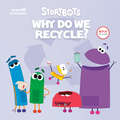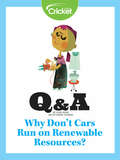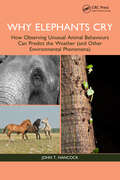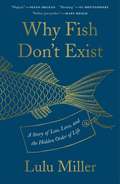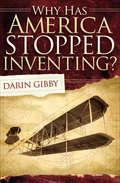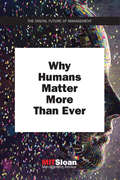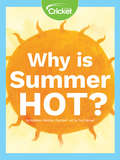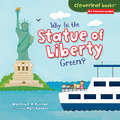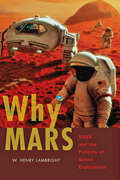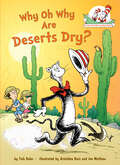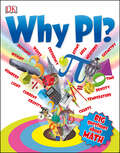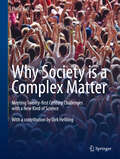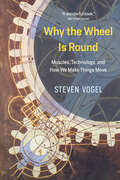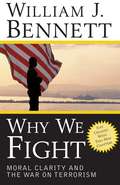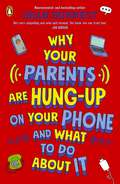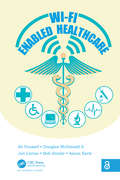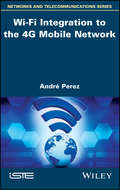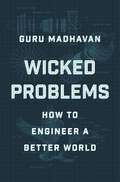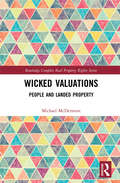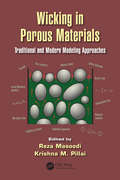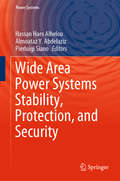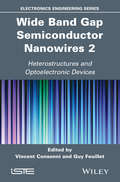- Table View
- List View
Why Do We Recycle? (Pictureback(R))
by Scott EmmonsThe curious crew from Netflix's Ask the StoryBots star in an all-new storybook about recycling that includes over 30 stickers! Bing, Bo, and the rest of Netflix&’s StoryBots want to know where garbage goes. Join them on an adventure that takes them from the landfill to the recycling plant. Children ages 3 to 7 who love Ask the StoryBots will thrill to this fun and fascinating storybook that includes over 30 stickers. The stars of Netflix&’s Ask the StoryBots are curious little robots who bring a world of learning and fun to kids ages 2 to 7 across a broad range of subjects with their animated series. All of the award-winning StoryBots content is developed by teachers and early-education experts.
Why Don't Cars Run on Renewable Resources?
by Lizzie WadeA bioengineer at Tel Aviv University in Israel explains how to extract renewable energy from a potato.
Why Elephants Cry: How Observing Unusual Animal Behaviours Can Predict the Weather (and Other Environmental Phenomena)
by John T. HancockWhy Elephants Cry is a fascinating frolic through the literature and evidence surrounding the use of unusual behavior of animals to measure and predict the environment. The role of animals, from the smallest ant to the biggest elephant, as predictors of environmental changes is framed around the climate crisis, which highlights the increasingly important part that animals will have to play in the future. Renowned biologist Professor John T. Hancock collects anecdotal stories and myths along with scientific evidence, demonstrating that observation of animals can be of tangible use. He looks at the measurement of the air temperature using ants, crickets and snakes, and goes on to assess the evidence that the observation of a wide range of animals can predict the weather or the imminent eruption of volcanoes and earthquakes. Evidence of animals being able to predict lunar and solar events, such as lunar cycles and the Northern Lights, is also considered. This is the only time that all this literature has been brought together in one place, a fascinating reference for anybody interested in animals and the environment. The book is also an ideal supplementary textbook for students studying animal behaviour.
Why Fish Don't Exist: A Story of Loss, Love, and the Hidden Order of Life
by Lulu MillerA wondrous debut from an extraordinary new voice in nonfiction, Why Fish Don&’t Exist is a dark and astonishing tale of love, chaos, scientific obsession, and—possibly—even murder. David Starr Jordan was a taxonomist, a man possessed with bringing order to the natural world. In time, he would be credited with discovering nearly a fifth of the fish known to humans in his day. But the more of the hidden blueprint of life he uncovered, the harder the universe seemed to try to thwart him. His specimen collections were demolished by lightning, by fire, and eventually by the 1906 San Francisco earthquake—which sent more than a thousand of his discoveries, housed in fragile glass jars, plummeting to the floor. In an instant, his life&’s work was shattered. Many might have given up, given in to despair. But Jordan? He surveyed the wreckage at his feet, found the first fish he recognized, and confidently began to rebuild his collection. And this time, he introduced one clever innovation that he believed would at last protect his work against the chaos of the world. When NPR reporter Lulu Miller first heard this anecdote in passing, she took Jordan for a fool—a cautionary tale in hubris, or denial. But as her own life slowly unraveled, she began to wonder about him. Perhaps instead he was a model for how to go on when all seemed lost. What she would unearth about his life would transform her understanding of history, morality, and the world beneath her feet. Part biography, part memoir, part scientific adventure, Why Fish Don&’t Exist reads like a fable about how to persevere in a world where chaos will always prevail.
Why Gut Microbes Matter: Understanding Our Microbiome (Fascinating Life Sciences)
by Harry J. FlintGiven the at times confusing new information concerning the human microbiome released over the last few years, this book seeks to put the research field into perspective for non-specialists. Addressing a timely topic, it breaks down recent research developments in a way that everyone with a scientific background can understand.The book discusses why microorganisms are vital to our lives and how our nutrition influences the interaction with our own gut bacteria. In turn, it goes into more detail on how microbial communities are organised and why they are able to survive in the unique environment of our intestines. Readers will also learn about how their personal microbial profile is as unique as their fingerprint, and how it can be affected by a healthy or unhealthy lifestyle. Thanks to the open and easy-to-follow language used, the book offers an overview for all readers with a basic understanding of biology, and sheds new light on this fascinating and important part of our bodies.
Why Has America Stopped Inventing?
by Darin GibbyA thoughtful look at our history of innovation, the problems with the patent system, and the prospects for America&’s future. America loves innovation and the can-do spirit that made this country what it is—a world leader in self-government, industry and technology, and pop culture. Everything about America has at one point or another been an experiment and a leap of faith. And one such experiment—upon which all others depend for success—is the US Patent System. Why Has America Stopped Inventing? takes a close look at why this experiment appears to be failing, and why America has all but stopped inventing. Our belief that we are the most innovative people on earth is mistaken. Statistics show that today we invent less than half of what our counterparts did a hundred and fifty years ago. Where are the groundbreaking inventions comparable to those from the Industrial Revolution? Why have we been using the same mode of transportation for over a century? Why are we giving trillions to hostile foreign nations for imported oil when we have the talent to solve the nation&’s energy crisis? We don&’t have these desperately needed technologies because regular Americans have given up on inventing. This book explains why, comparing the experiences of America&’s most successful nineteenth-century inventors with those of today and sharing fascinating historical anecdotes: Jefferson refusing to waste any more weekends examining patent applications; Whitney being robbed of his fortune while the South&’s wealth exploded; the patent models that kept British soldiers from burning Washington&’s last-standing federal building; the formation of Lincoln&’s cabinet; and Selden crippling the entire US auto industry. It also tells the story of the Wright brothers&’ airplane monopoly, the Colt revolver&’s role in the Mexican American War, the Sewing Machine wars, the last six months of Daniel Webster&’s life, and the fraudulently created Bell Empire.
Why Hospitals Should Fly: The Ultimate Flight Plan to Patient Safety and Quality Care
by John J. NanceThe facts are irrefutable. Despite the "wakeup call" from the Institute of Medicine (IOM) in 1999, tens of thousands of patients still die unnecessarily and hundreds of thousands are injured by medical mistakes every year. It is currently estimated by the CDC, for example, that as many as 90,000 people die from hospital acquired infections alone. At least 10 percent of patients admit¬ted to hospitals are injured by things going wrong in their care.
Why Humans Matter More Than Ever (The Digital Future of Management)
by MIT Sloan Management ReviewExperts offer strategies for managing people in technocentric times.In these technocentric times, it is more important than ever to manage people well. Companies—employees and managers—may feel overwhelmed by the never-ending disruptions caused by new technologies. This volume in the Digital Future of Management series shows why we should step back, take stock, and seize just a bit more control over how our world is evolving. In Why Humans Matter More Than Ever, management experts from both industry and academia offer strategies for managing people in our brave new digital world.The contributors explain how new technologies, even the most sophisticated artificial intelligence agents, depend on human collaboration. Companies need to develop rules, principles, and clear ethical guidelines that structure smart object–human interactions. Moreover, in a world filled with technology distractions, we must learn to how to manage our most valuable personal resource: our attention. Leaders need to step up to prepare their organizations for the evolution of work, showing them how to adapt, be more collaborative, and learn new skills. As virtual collaborations take place across professions, locations, and industries, we must adopt the best practices in virtual communication. Finally, going beyond empathy and curiosity, leaders should be self-aware enough to remind themselves of what they may be missing—even the best managers don't know everything. Contributors Lynne Andersson, Robert D. Austin, Catherine Bailey, Kathryn M. Bartol, Daniel Han Ming Chng, Chris DeBrusk, Arati Deo, Kishore Durg, Lauren Eskreis-Winkler, Mallika Fernandes, Ayelet Fishbach, Fritz Fleischmann, Kristen Getchell, Bhaskar Ghosh, Brad Gilbreath, Rob Gleasure, Sergey Gorbatov, Lynda Gratton, N. Sharon Hill, Beth Humberd, Bala Iyer, Tae-Yeol Kim, Frieda Klotz, Angela Lane, Scott Latham, Thomas W. Malone, Daniel McDuff, Alain Pinsonneault, Yasser Rahrovani, Fabrizio Salvador, Amanda Shantz, Antti Tenhiälä, Jan vom Brocke, Eoin Whelan
Why Is Summer Hot?
by Kathleen Weidner ZoehfeldHave you ever wondered why the days are so long in the summer and short in the winter? Or why we have hot weather and colder weather? Read on to learn about how the Earth, how it spins around the Sun, and the seasons!
Why Is the Statue of Liberty Green? (Cloverleaf Books (tm) -- Our American Symbols Ser.)
by Martha E. Rustad Holli CongerDo you know that the Statue of Liberty hasn't always looked green? Or that the first torch had to be replaced? Lady Liberty has been an important US symbol for more than one hundred years. Join Mrs. Bolt's class as they visit the statue and learn where the statue came from, how she was built, and what American ideas she represents.
Why Mars: NASA and the Politics of Space Exploration (New Series in NASA History)
by W. Henry LambrightTraces NASA’s torturous journey to Mars from the fly-bys of the 1960s to landing rovers and seeking life today.Mars has captured the human imagination for decades. Since NASA’s establishment in 1958, the space agency has looked to Mars as a compelling prize, the one place, beyond the Moon, where robotic and human exploration could converge. Remarkably successful with its roaming multi-billion-dollar robot, Curiosity, NASA’s Mars program represents one of the agency’s greatest achievements. Why Mars analyzes the history of the robotic Mars exploration program from its origins to today. W. Henry Lambright examines the politics and policies behind NASA's multi-decade quest, illuminating the roles of key individuals and institutions along with their triumphs and defeats.Lambright outlines the ebbs and flows of policy evolution, focusing on critical points of change and factors that spurred strategic reorientation. He explains Mars exploration as a striking example of "big science" and describes the ways a powerful advocacy coalition—composed of NASA decision makers, the Jet Propulsion Laboratory, the Mars academic science community, and many others—has influenced governmental decisions on Mars exploration, making it, at times, a national priority.The quest for Mars stretches over many years and involves billions of dollars. What does it take to mount and give coherence to a multi-mission, big science program? How do advocates and decision makers maintain goals and adapt their programs in the face of opposition and budgetary stringency? Where do they succeed in their strategies? Where do they fall short? Lambright’s insightful book suggests that from Mars exploration we can learn lessons that apply to other large-scale national endeavors in science and technology.
Why Oh Why Are Deserts Dry? All About Deserts: All About Deserts (The Cat in the Hat's Learning Library)
by Tish RabeLaugh and learn with fun facts about desert animals, cacti, sand dunes, and more—all told in Dr. Seuss&’s beloved rhyming style and starring the Cat in the Hat! &“You may think that deserts are empty and bare, but you&’ll be surprised by the things we&’ll find there...&” The Cat in the Hat&’s Learning Library series combines beloved characters, engaging rhymes, and Seussian illustrations to introduce children to non-fiction topics from the real world! Journey through the deserts of the world and learn: how plants and animals have adapted to survive the unforgiving climatewhy deserts don&’t have to be hotwhat causes us to see miragesand much more! Perfect for story time and for the youngest readers, Why Oh Why Are Deserts Dry? All About Deserts also includes an index, glossary, and suggestions for further learning.Look for more books in the Cat in the Hat&’s Learning Library series!Cows Can Moo! Can You? All About FarmsHark! A Shark! All About SharksIf I Ran the Dog Show: All About DogsOh Say Can You Say Di-no-saur? All About DinosaursOn Beyond Bugs! All About InsectsOne Vote Two Votes I Vote You VoteThere&’s No Place Like Space: All About Our Solar SystemWho Hatches the Egg? All About EggsWish for a Fish: All About Sea Creatures
Why Pi? (Big Questions)
by Johnny BallThis entertaining follow-up to DK's popular Go Figure!, Why Pi? presents even more mind-bending ways to think about numbers. This time, author Johnny Ball focuses on how people have used numbers to measure things through the ages, from the ways the ancient Egyptians measured the pyramids to how modern scientists measure time and space. Johnny Ball has hosted more than 20 UK children's television series about math and science. He is known for making math not just easy to understand, but genuinely fun and fascinating. His shows and videos earned him a New York international EMMY nomination, a BAFTA, and 10 other awards. He has written five children's books, including DK's Go Figure!, and an educational musical. His academic credentials include three honorary science doctorates and fellowship of the British Mathematical Association.
Why Society is a Complex Matter
by Philip BallSociety is complicated. But this book argues that this does not place it beyond the reach of a science that can help to explain and perhaps even to predict social behaviour. As a system made up of many interacting agents - people, groups, institutions and governments, as well as physical and technological structures such as roads and computer networks - society can be regarded as a complex system. In recent years, scientists have made great progress in understanding how such complex systems operate, ranging from animal populations to earthquakes and weather. These systems show behaviours that cannot be predicted or intuited by focusing on the individual components, but which emerge spontaneously as a consequence of their interactions: they are said to be 'self-organized'. Attempts to direct or manage such emergent properties generally reveal that 'top-down' approaches, which try to dictate a particular outcome, are ineffectual, and that what is needed instead is a 'bottom-up' approach that aims to guide self-organization towards desirable states. This book shows how some of these ideas from the science of complexity can be applied to the study and management of social phenomena, including traffic flow, economic markets, opinion formation and the growth and structure of cities. Building on these successes, the book argues that the complex-systems view of the social sciences has now matured sufficiently for it to be possible, desirable and perhaps essential to attempt a grander objective: to integrate these efforts into a unified scheme for studying, understanding and ultimately predicting what happens in the world we have made. Such a scheme would require the mobilization and collaboration of many different research communities, and would allow society and its interactions with the physical environment to be explored through realistic models and large-scale data collection and analysis. It should enable us to find new and effective solutions to major global problems such as conflict, disease, financial instability, environmental despoliation and poverty, while avoiding unintended policy consequences. It could give us the foresight to anticipate and ameliorate crises, and to begin tackling some of the most intractable problems of the twenty-first century.
Why the Wheel Is Round: Muscles, Technology, and How We Make Things Move
by Steven VogelThere is no part of our bodies that fully rotates--be it a wrist or ankle or arm in a shoulder socket, we are made to twist only so far. And yet there is no more fundamental human invention than the wheel--a rotational mechanism that accomplishes what our physical form cannot. Throughout history, humans have developed technologies powered by human strength, complementing the physical abilities we have while overcoming our weaknesses. Providing a unique history of the wheel and other rotational devices--like cranks, cranes, carts, and capstans--Why the Wheel Is Round examines the contraptions and tricks we have devised in order to more efficiently move--and move through--the physical world. Steven Vogel combines his engineering expertise with his remarkable curiosity about how things work to explore how wheels and other mechanisms were, until very recently, powered by the push and pull of the muscles and skeletal systems of humans and other animals. Why the Wheel Is Round explores all manner of treadwheels, hand-spikes, gears, and more, as well as how these technologies diversified into such things as hand-held drills and hurdy-gurdies. Surprisingly, a number of these devices can be built out of everyday components and materials, and Vogel's accessible and expansive book includes instructions and models so that inspired readers can even attempt to make their own muscle-powered technologies, like trebuchets and ballista. Appealing to anyone fascinated by the history of mechanics and technology as well as to hobbyists with home workshops, Why the Wheel Is Round offers a captivating exploration of our common technological heritage based on the simple concept of rotation. From our leg muscles powering the gears of a bicycle to our hands manipulating a mouse on a roller ball, it will be impossible to overlook the amazing feats of innovation behind our daily devices.
WHY vs WHY Nuclear Power
by Barry Brook Ian LoweIn WHY vs WHYTM Nuclear Power, we pit two opposing activists & writers against each other, Barry Brook & Ian Lowe. They go head-to-head, each presenting 7 key reasons why you should say yes/no to nuclear power. After each author presents his arguments, his opponent tries to tear each of them apart, both in the book & on this website (with further rebuttals). For readers, we aim to leave nothing unanswered. Barry & Ian are good writers with strong, well-argued opinions. Who will you agree with? Will one of them change your mind? Read the book & find out. In WHY vs WHYTM, you get both sides, so you can decide for yourself... The books are also a great tool to help you convince others, people who don't see the light the way you do. Buy them a copy!
Why We Fight: Moral Clarity and the War on Terrorism
by William J. BennettThe events of September 11, 2001, were an unforgettable tragedy, but they also revealed that the spirit of America is strong and undiminished. Not since the shocking attack on Pearl Harbor has the nation pulled together with such unity and purpose, resolving to endure whatever hardships may be necessary to win the war on terror. We were united in the defense of and belief in our country. It truly brought out the best in our national character. In clear, compelling, straightforward language, William Bennett takes up and refutes the many myths and misconceptions about America’s character and role in world affairs that have become fashionable among our nation’s elites. The morning of September 12 dawned with a stunning moral clarity that has guided the actions of many Americans, both her leaders and her citizens. Bennett seeks to preserve that clarity in order to ensure that our national resolve does not falter in this difficult and necessary war.
Why Your Parents Are Hung-Up on Your Phone and What To Do About It
by Dean Burnett'Dean Burnett is the first old person who understands phones' Eleven-year-old Dermot, quoted in The Times'A wonderfully useful book, told with Dean Burnett's trademark wit and wisdom' - Adam Kay on Why Your Parents Are Driving You up the Wall“Can you get off your phone/ PS5/ Xbox!? NOW!” - Your parents (probably)I bet that you and your parents argue about phones.Maybe you want one, but your parents don’t agree? Or maybe you do have a phone, but your parents think you use it too much. Or even make you leave it downstairs at night when you want to scroll before sleep.Either way, the result is: arguments. Between you and your parents. About phones.Meet brain scientist and bestselling author Dean Burnett. He’ll show you why your parents are sometimes wrong about phones (and why, annoyingly, they can be a bit right), how you can both understand them a bit better and how you can stop arguing about them. You’ll learn about:Why turning off TikTok can be so hardHow video games can change your brain for the betterHow Snapchat can make us sad (and lots of other complicated feelings)Because screens can be a good thing. And a bad thing. But they’re definitely not worth getting hung up about.
Wi-Fi Enabled Healthcare
by Ali Youssef Douglas McDonald II Jon Linton Bob Zemke Aaron EarleFocusing on the recent proliferation of Wi-Fi in hospital systems, this book explains how Wi-Fi is transforming clinical work flows and infusing new life into the types of mobile devices being implemented in hospitals. Drawing on years of consulting with hospitals in the US and abroad, and with first-hand experiences from one of the largest healthcare systems in the United States, it covers the key areas associated with wireless network design, security, and support. Reporting on cutting-edge developments and emerging standards in Wi-Fi technologies, the book explores security implications for each device type. It covers real-time location services and emerging trends in cloud-based wireless architecture.
Wi-Fi Integration to the 4G Mobile Network
by Andre PerezThe adoption of smartphones has had as a corollary the use of services that require streaming, such as video streaming, which is a constraint for the 4G mobile network. The integration of the network of Wi-Fi hotspots deployed by the operators adds capacity to the 4G mobile network.The use of Wi-Fi technology in carrier networks is the result of developments coordinated by the IEEE, WFA and WBA standardization bodies. For its part, the 3GPP standardization body has been working to integrate Wi-Fi technology into the 4G mobile network.The first part of this book presents the characteristics of the Wi-Fi radio interface. The different IEEE 802.11b / g / n / ac physical layers characterize the implementation in the 2.4 GHz ISM frequency bands and U- NII at 5 GHz. The MAC layer defines a number of media access procedures such as scanning, associating, or transferring data.The second part of this book deals with the architecture of the 4G network based on the Wi-Fi interface. This architecture defines several models corresponding, on the one hand, to Wi-Fi access controlled or not, On the other hand, to a handover controlled by the network or by the mobile. The integration of Wi-Fi technology resulted in a redefinition of attachment and session set-up procedures.Smartphones have the ability to activate simultaneously the two radio interfaces, LTE and Wi-Fi, which allows to direct certain services to one and / or the other of the interfaces. The ANDSF and HotSpot 2.0 functions provide the mobile with rules for network selection and traffic control to determine which traffic is to be routed to what type of interface.
Wicked Problems: How to Engineer a Better World
by Guru MadhavanAn ode to systems engineers—whose invisible work undergirds our life—and an exploration of the wicked problems they tackle. Our world is filled with pernicious problems. How, for example, did novice pilots learn to fly without taking to the air and risking their lives? How should cities process mountains of waste without polluting the environment? Challenges that tangle personal, public, and planetary aspects—often occurring in health care, infrastructure, business, and policy—are known as wicked problems, and they are not going away anytime soon. In linked chapters focusing on key facets of systems engineering—efficiency, vagueness, vulnerability, safety, maintenance, and resilience—engineer Guru Madhavan illuminates how wicked problems have emerged throughout history and how best to address them in the future. He examines best-known tragedies and lesser-known tales, from the efficient design of battleships to a volcano eruption that curtailed global commerce, and how maintenance of our sanitation systems constitutes tikkun olam, or repair of our world. Braided throughout is the uplifting tale of Edwin Link, an unsung hero who revolutionized aviation with his flight trainer. In Link’s story, Madhavan uncovers a model mindset to engage with wickedness. An homage to society’s innovators and maintainers, Wicked Problems offers a refreshing vision for readers of all backgrounds to build a better future and demonstrates how engineering is a cultural choice—one that requires us to restlessly find ways to transform society, but perhaps more critically, to care for the creations that already exist.
Wicked Valuations: People and Landed Property (Routledge Complex Real Property Rights Series)
by Michael McDermottTraditional valuation approaches are increasingly recognised as being insufficient to address the wicked valuation problems of the diverse peoples and groups that inhabit the globe from north, south, east to west. This book demonstrates the limitations of science and, in particular economics, as the foundation on which valuations are traditionally based. It demonstrates the importance of and provides justification for the personal, cultural values and norms which underpin our assessment of "value", and the fact that these vary across the world. In Wicked Valuations Michael McDermott develops a means of engaging with highly complex valuation problems. His autoethnography provides a lens to draw on knowledge and experience from his 40 years in land valuation in Africa and the Asia-Pacific, while documentary analysis is used to draw in the views of other valuation practitioners and scholars who are becoming increasingly aware of the need to develop ways to adapt land valuation processes to the complexity of our contemporary landscapes.
Wicking in Porous Materials: Traditional and Modern Modeling Approaches
by Reza Masoodi Krishna M. PillaiThis reference offers information on the science and advances of wicking in porous materials. It describes various modeling approaches, traditional and modern, but maintains an emphasis on the modern methodologies. A host of internationally recognized scientists and researchers contribute chapters that describe the physics of wicking and the different approaches available for modeling wicking. Chapters cover measurement of wetting parameters such as surface tension and contact angle; the Washburn Equation; measurement of various quantities; wicking in rigid porous materials; wicking in swelling porous materials; and two-phase flow approaches to modeling wick flow.
Wide Area Power Systems Stability, Protection, and Security (Power Systems)
by Hassan Haes Alhelou Almoataz Y. Abdelaziz Pierluigi SianoThis book proposes new control and protection schemes to improve the overall stability and security of future wide-area power systems. It focuses on the high penetration levels of renewable energy sources and distributed generation, particularly with the trend towards smart grids.The control methods discussed can improve the overall stability in normal and abnormal operation conditions, while the protection methods presented can be used to ensure the secure operation of systems under most severe contingencies.Presenting stability, security, and protection methods for power systems in one concise volume, this book takes the reader on a journey from concepts and fundamentals to the latest and future trends in each topic covered, making it an informative and intriguing read for researchers, graduate students, and practitioners alike.
Wide Band Gap Semiconductor Nanowires 2: Heterostructures and Optoelectronic Devices (Wiley-iste Ser.)
by Robert BaptistThis book, the second of two volumes, describes heterostructures and optoelectronic devices made from GaN and ZnO nanowires. Over the last decade, the number of publications on GaN and ZnO nanowires has grown exponentially, in particular for their potential optical applications in LEDs, lasers, UV detectors or solar cells. So far, such applications are still in their infancy, which we analyze as being mostly due to a lack of understanding and control of the growth of nanowires and related heterostructures. Furthermore, dealing with two different but related semiconductors such as ZnO and GaN, but also with different chemical and physical synthesis methods, will bring valuable comparisons in order to gain a general approach for the growth of wide band gap nanowires applied to optical devices
